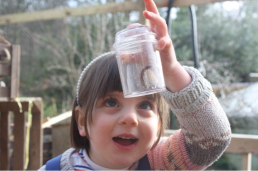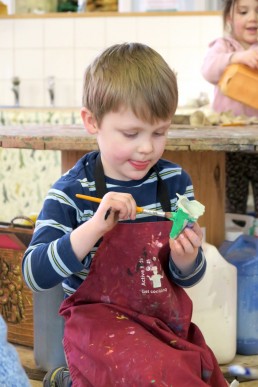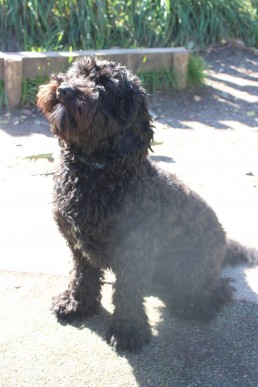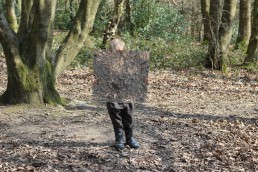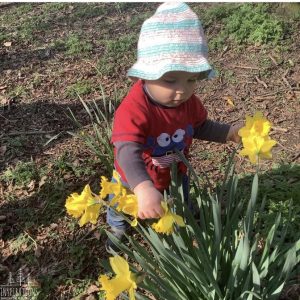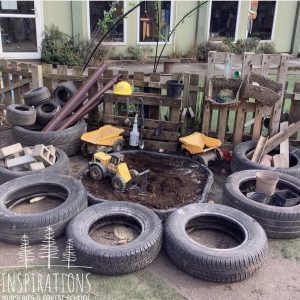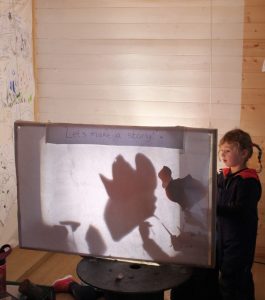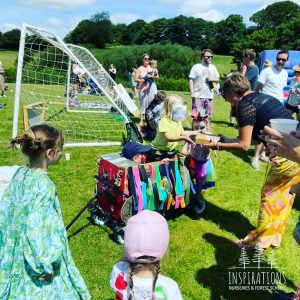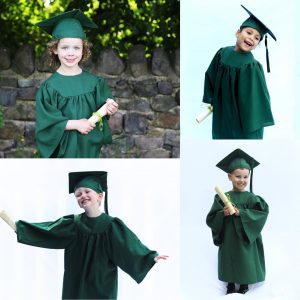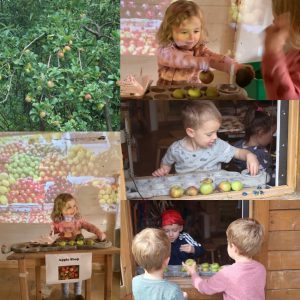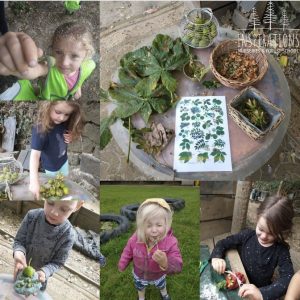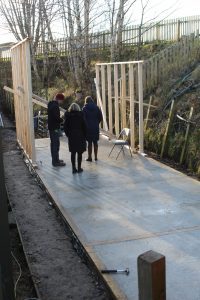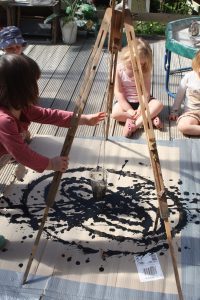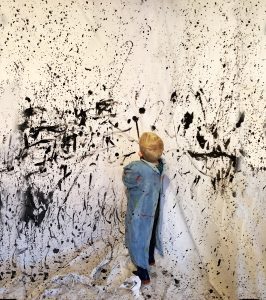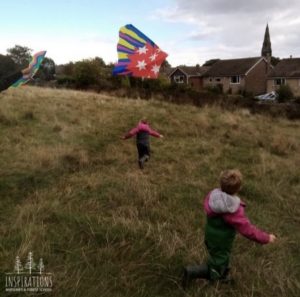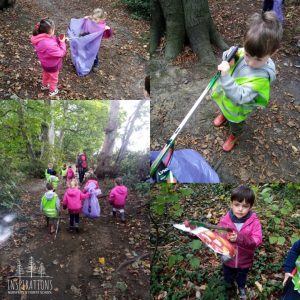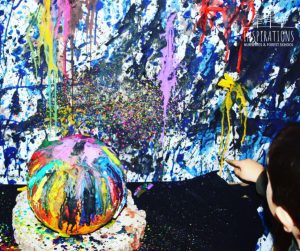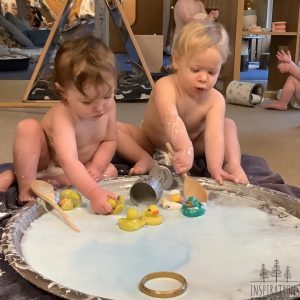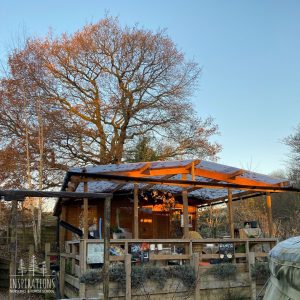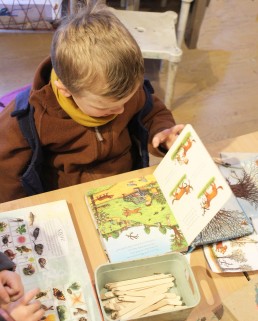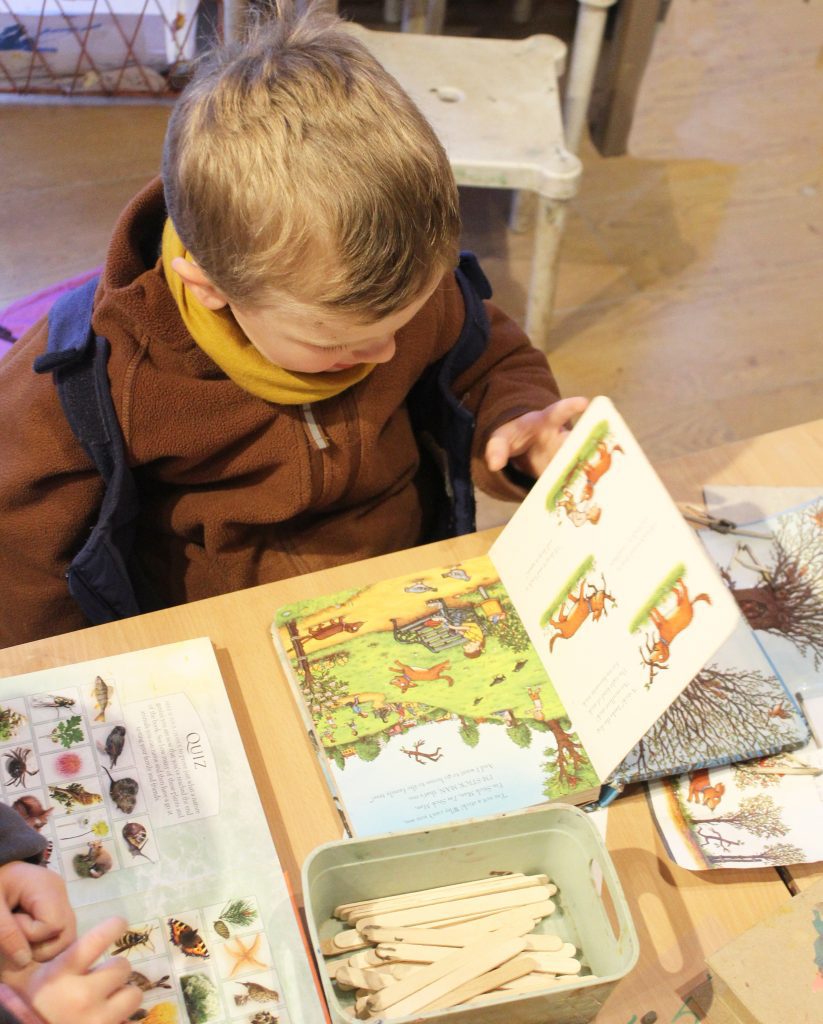Other Ways to Communicate

When we talk about communication people often only think about speech, but there are lots of different ways to communicate. Eye contact, body language, facial expressions, gestures, and drawing and writing are daily tools we might use for sharing information.
At Inspirations we follow the Reggio Emilia approach, where one of our key principles is the ‘hundred languages of learning’. The principle refers to communication and the one hundred ways children can express and process the world around them. It provides children opportunities to engage through arts and media, light and shadow and music.
At Inspirations we implement this approach through our daily sessions. The pre-school children decide where they would like to go at choosing times. They may choose to stay in the yurt and outdoor classroom, where the environment is carefully set up by trained staff which use the children’s interests to extend their learning, or they may decide to go off site. Our child-led curriculum provides forest school and art studio workshops twice a day, for two hours. Working in small groups in the art studio ensures that the children can work intimately on projects, expressing their thoughts and ideas through a diverse range of mediums. The forest school sessions provide a breadth of natural resources for the children, and with the guidance from trained staff, a world of beauty, connection, movement and autonomy.
Communicating in all the different ways may come easier to some people than others and some may find them all challenging. Some people may have conditions which can affect the way they communicate. For example, someone who is autistic will often have difficulties when it comes to communicating, especially in social situations. Some people struggle to verbally communicate so will need to learn other non-verbal methods.
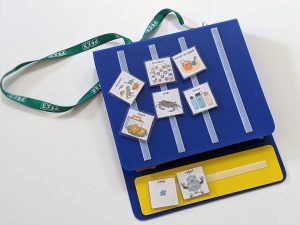 In our nursery each room is supplied with visual aids. This picture-based resource enables babies and children that are preverbal to interact with us. Visuals provide good support to a verbal instruction and help children to understand and make connections. When necessary, we also use Boardmaker which is a software often used across Leeds to support children with Special Educational Needs and Disabilities (SEND) as well as children with English as an additional language. Using resources that they may use when they move on from us is important for consistency. Some children may need PECS, which is a Picture Exchange Communication System. This is a unique communication tool using Boardmaker to enable children to communicate their wants and needs. The programme involves another person acting as the communicative partner, responding to the child's requests. It teaches children that communication is an exchange and how to put words together to form a sentence.
In our nursery each room is supplied with visual aids. This picture-based resource enables babies and children that are preverbal to interact with us. Visuals provide good support to a verbal instruction and help children to understand and make connections. When necessary, we also use Boardmaker which is a software often used across Leeds to support children with Special Educational Needs and Disabilities (SEND) as well as children with English as an additional language. Using resources that they may use when they move on from us is important for consistency. Some children may need PECS, which is a Picture Exchange Communication System. This is a unique communication tool using Boardmaker to enable children to communicate their wants and needs. The programme involves another person acting as the communicative partner, responding to the child's requests. It teaches children that communication is an exchange and how to put words together to form a sentence.
In our baby rooms we use Makaton during singing times and for other frequent words such as ‘more’ or ‘drink’. Makaton involves signing key words, using a spoken word at the same time. Although it is not an official form of signing, it is based on signs used in the British Sign Language. Makaton was developed for very young children with special needs or other communicative challenges. It is helpful for someone who can hear but has difficulties with communication as it uses symbols, verbal words and hand signs.
Kayleigh Woolger
The well-being of employees
The Oxford Language Dictionary describes well-being as ‘the state of being comfortable, healthy or happy’.
Unfortunately, coping and addressing mental health conditions now appears to be an integral part of the society we live in and even more so since the COVID-19 pandemic. It seems to have become the way of the world and statistics show that 1 in 6.8 people experience mental health problems in the workplace, and stress, anxiety and depression accounts for 51% of all work-related ill health cases.
Stress within the early years sector is particularly bad at the moment. Nursery World reported that 1 in 4 early years workers are considering leaving. Pressures, such as staff recruitment are a big contributing factor to the impact on the quality of employees work life. Having to substitute quality qualified employees with staff from agencies, who don’t know the routines and the children in our care, inevitably creates a very stressful day.
Another area that is becoming more recognised as an area to support employees within is the Menopause/Perimenopause. Although women may experience different symptoms through the change, we are learning to meet their needs by offering additional support with shift times (due to sleepless nights), doctor appointments and more understanding towards changes in behaviour and attitudes.
Supporting employees with their well-being is paramount in helping them cope mentally and spiritually. Within Inspirations we do our best to uphold this as we are aware women, of which we are predominately based, in full-time employment are nearly twice as likely to have a common mental health problem as opposed to that of men.
There are so many avenues nowadays that support those suffering and struggling, for example helplines (MIND and Samaritans), NHS talking therapies (IAPT), apps such as CALM, social media, and podcasts. It is a subject that is a lot more recognised and talked about for both MEN and WOMEN.
Below are some of the things we do to support staff wellbeing:
- Shout out board – staff and parents can add to this and these are read out in our staff meetings
- Termly supervisions and yearly appraisals are held to check in with staff
- Hot meals available, as well as condiments such as tea, coffee and juice
- Fruit and healthy snacks for break times
- Everyday essentials such as feminine products deodorant etc
- Well-being program – downloadable app to help and support as well as a 24/7 advice line that can put you in touch with counsellors (with 6 free sessions)
- Team building activities
- Comfy, relaxing staff room
- Paid training
- Food provided during staff meetings
- Birthday cakes to celebrate individual birthdays
- Christmas party
Having an open doors policy to the office is highlighted within our policy and vital to support the staff the best we can. Management are always available if staff require a friendly ear. We also have a mental health first aider on site who can help advise employees, as well as room leaders and deputy room leaders trained in ‘supporting staff with well-being in the early years.’
If you have been reading this and it has given you the confidence to express your anxieties, stress, well-being then please see below a couple of contacts of agencies that can help…
MIND - 03001233393
SAMARITANS – 988
Ashleigh Benson
Coaching vs Training
What is the difference coaching vs training?
Training is designed to increase knowledge and skills. Coaching is designed to increase self-awareness about attitude, behaviors, choices, and development needs.

What does it look like in practice?
Training and mentoring are about the transferring of knowledge from teacher to student.Coaching is about enhancing, supporting, and facilitating the practitioner to step in and be actively engaged in their own growth and knowledge. Drawing out the skills and training they already have.
Many practitioners have a wealth of knowledge and so the early years training might not be best for them. Since, and during the pandemic online training has become very popular and lots of companies provide many wonderful courses. We all seem to have lots of certificates and are totally aware of the importance of our Continuing Professional Development (CPD) but are we seeing it in practice?
This is where coaching comes in. Coaching is about working alongside everyday practitioners in the setting, to implement training that they already have. It also provides the opportunity for the practitioner to get a huge amount of knowledge and expertise delivered in the moment.
The obvious drawback with coaching can be the cost! It can vary in price and can be expensive. Settings need to look at the current qualifications and skills they already have and build from there. Are we seeing those skills in practice? If not, coaching needs to be considered. As a trainer this is something I want to implement within our setting. Sharing and showing our skills, knowledge and experience should be key for development.
Coaching is also a wonderful way for positive role modelling to be demonstrated. Many factors influence the behaviour of children in early years settings. The behaviour of people who work closely with children has a great effect and influence. We all cope differently in stressful situations, so having a person to coach and mentor you through challenging times is invaluable.
We want to develop a coaching culture at inspirations. Where everyone feels valued and supported. A coaching culture improves the way we are with each other, but also our interactions with the children. At its core, it is about helping people get from where they are to where they want to go. Whether privately or in a group, coaching empowers people to increase their self-awareness and self-esteem.
Tara Slade
The importance of STEM/STEAM learning in EYFS (Science, Technology, Engineering, Art and Maths)
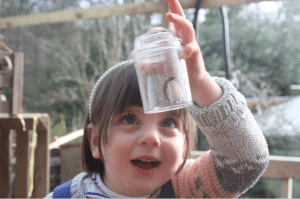
Young children are the ultimate sources of wonder and natural curiosity, with limitless drives to explore. They are the world's natural problem solvers, seeking new and exciting challenges and ways to ‘do’ and improve things. They predict outcomes, test their ideas or questions, spot patterns, estimate and evaluate critically. Through incorporating aspects of STEAM into our child-led-play environment, children are encouraged to develop their resilience and to communicate, work collaboratively and to make compromises.
Each of these skills are aspects of the EYFS Characteristics of Effective Learning. At Inspirations Nurseries I believe that STEAM is naturally embedded in our ethos and pedagogy and should be in all early years education and settings.
STEAM is a multidisciplinary and holistic approach to teaching these subjects, which is what our provision is based on, the areas where learning overlaps. Our outdoor setting/classrooms, art studios and child-led learning approach already provides a rich STEAM enabling environment where children can experiment, explore and have a wonder for their world.
Science is fully embedded in our provision: within the daily and seasonal links to nature, cycles (tadpoles/chicks/weather/water/decomposition) and the equilibrium needed for different types of energy (their transfers and ‘cause and effect’). It is in chemical reactions, materials and their properties, in temperature, size, force and motion.
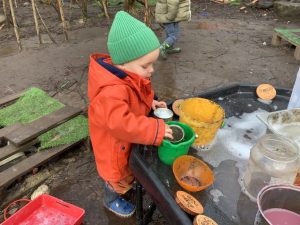 We support our children to experiment with ‘cause and effect’, providing sensory experiences with construction and creative media resources, using containers, utensils and other tools for transforming materials from solids to liquids. We use textured materials and ramps with vehicles to investigate the speed and force of objects in a developmentally and appropriate way.
We support our children to experiment with ‘cause and effect’, providing sensory experiences with construction and creative media resources, using containers, utensils and other tools for transforming materials from solids to liquids. We use textured materials and ramps with vehicles to investigate the speed and force of objects in a developmentally and appropriate way.
In the last few weeks, the children in our toddler room have been blending, stirring, whisking silly soups and potions. They have been measuring ingredients when making pancakes and looking at the capacity of containers in the water trays. Our pre-schoolers have been using magnifying glasses to observe various "minibeasts" collected from various locations around nursery, whilst extending their interest of digging and improving their fine motor skills.
Technology, and tools like projectors, cameras, microscopes, sensory toys, lights, mark making and cutting tools, are part of our continuous provision. We also use online platforms and apps to provide learning opportunities for children to record and observe. Technology helps children to make discoveries and record findings, to explore the consistency, composition and uses of materials and resources.
We have a nursery full of budding engineers, and architects who daily stack, design, construct, connect, and build. They make houses, towers, bridges, and roads for their vehicles and containers, traversing and transporting which extends their own learning journey. As children play, staff promote STEAM in their interactions, provocations and questioning.
Our resident atelierista, provides a wealth of opportunities for extending STEM subjects and skills within the arts and creative play. A curriculum incorporating the arts has been proven to increase creativity, academic performance, motor skills, while enhancing visual learning and boosting higher decision-making and critical thinking skills.
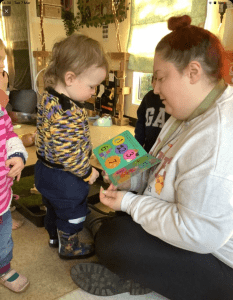 Mathematical literacy is enriched daily through singing and stories. Our environment and the continuous provision of resources, such as containers, funnels, measuring cylinders and loose parts, allow opportunities to compare size, capacities, volumes as well as categorisation of shapes and colour.
Mathematical literacy is enriched daily through singing and stories. Our environment and the continuous provision of resources, such as containers, funnels, measuring cylinders and loose parts, allow opportunities to compare size, capacities, volumes as well as categorisation of shapes and colour.
STEAM takes STEM to the next level by including the process of innovation and creativity. The integration of these principles through the arts fosters a generation of future innovators who can link their learning and skills together, removing limitations and replacing them instead with wonder, critique, inquiry, and innovation.
Kellianne Moulton
The Role of an Atelierista
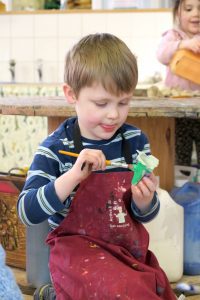 The Role of an Atelierista
The Role of an Atelierista
The atelier and atelierista are integral parts of the Reggio Emilia approach. The atelierista, a teacher with a background in the arts, works together with children in the atelier (studio). Together they will often embark on long-term projects and experiment with a variety of creative mediums. The atelier is a learning space and shared environment where children can express themselves through ‘the hundred languages’. This may be through singing, drawing, dancing, clay or natural materials. ‘The hundred languages’ represents the infinite potential where children can express their learnings, feelings and ways in which they comprehend the world.
As an atelierista, I have witnessed how effective the Reggio-inspired approach is in contrast to traditional education. Children have an innate sense of curiosity and awe and when presented with a range of resources and materials, they expand their inquisitive minds. Interestingly, artists are often trying to channel this child-like wonder, exploring with a sense of openness without the restriction of doubts and fears. Therefore, I believe in utilising this inner curiosity and creating a space where life-long learners and artists can emerge.
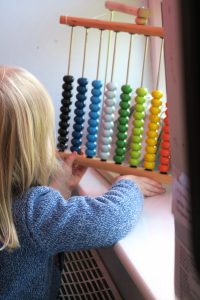 Rather than conforming to the role of a teacher in a traditional sense, as an atelierista I learn alongside the children whilst encouraging problem solving, expression and communication. Together we are on an exciting adventure and learning process that unfolds before our eyes. In their own time, the children begin to master techniques and familiarise themselves with different mediums. This also provides me the opportunity to understand the different ways children learn, to observe each child as a unique individual.
Rather than conforming to the role of a teacher in a traditional sense, as an atelierista I learn alongside the children whilst encouraging problem solving, expression and communication. Together we are on an exciting adventure and learning process that unfolds before our eyes. In their own time, the children begin to master techniques and familiarise themselves with different mediums. This also provides me the opportunity to understand the different ways children learn, to observe each child as a unique individual.
Observing, listening, documenting and reflecting are essential to the role of an atelierista. Significantly, being alert and aware is crucial to witness the children’s discoveries, to hear meaningful conversations or to ask thought provoking questions. Only after this process can quotes, observations and notes be written. This documentation allows for deep reflection for both the atelierista and the children, in which interests, learning and progress can be shared. For me, it also reveals subtle patterns about the children’s behaviour and can indicate which direction we might take next. Documentation also enables me to truly listen to the voice of the child and respect their learning journey.
During my time as an atelierista, I am constantly surprised and delighted with what children discover. Each day is a new opportunity for exploration and insights, often stepping back and allowing for that magic to happen takes learning to a new level. This process, rather than the final product, is ultimately the most important part of a child’s journey. I think even as adults, we would benefit from engaging in the world with curiosity and to trust the process.
Julie Lai

Odin Our Nursery Dog
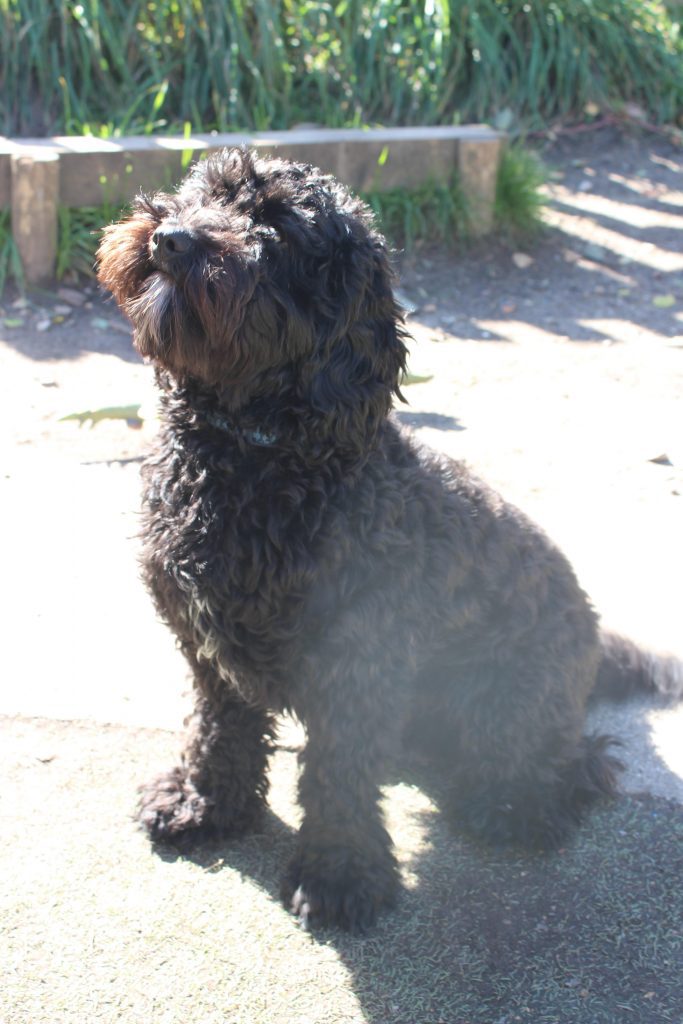
Have you met Odin at nursery? Odin is a cavapoo that comes to nursery on Mondays, Tuesdays and Thursdays, every week. A cavapoo is a cross between a Poodle and a King Charles Cavalier. They are both playful and affectionate breeds, which don’t tend to shed. He is hypoallergenic but no dog can be 100% hypoallergenic. However, he is bred from the most hypoallergenic breed, so may cause fewer symptoms in allergy sufferers. He is also very affectionate and loves a cuddle and a stroke!
Odin is my dog and I have been bringing him to nursery since I homed him at 10 weeks old. I researched and intentionally chose a cavapoo to be around children and the staff at nursery. He is a very sociable dog and loves the attention and interaction he gains from humans.
Pets bring comfort and companionship to some people. For some people having a cuddle or even a little stroke with a friendly dog can make them feel better if they are low or just need some comfort. In fact, research has been shown that just stroking a dog reduces stress levels and interacting with a dog increases levels of oxytocin (the feel-good hormone!). Some organisations who take part in mental health awareness, take visits from pets as therapy to support the people they are working with as part of their support network. It is becoming increasingly popular for childcare establishments, including schools and education, to bring a dog in to support the children and staff. They can support the schools to help children with their literacy skills and even encourage concentration in the classroom. For us, one of our aims was for children to become familiar with dogs, to learn how to behave around them and to gain the knowledge to care for them.
It is part of cultural capital that we close any gaps in the children’s learning. Not all families can have dogs, so therefore children can be unfamiliar with them. We also believe that children can benefit in other ways from regular interaction with animals. These ways include:
- emotional regulation
- increased understanding of responsibility
- development of empathy
Many children also get great enjoyment out of caring for and interacting with animals.
Our over 3’s use Hunger Hills woods for forest school sessions, twice a day. This is a very popular dog walking destination, so the children are greeted daily by dogs. Some dogs we know by name, and they are always happy to greet us. The children know what to expect and how to behave around them.
From being in our baby room, the children will meet Odin. He has specific times to explore the rooms and outdoor areas with very close adult supervision. The children are encouraged from a young age to be calm, not to put their hand in his face or to pull his fur and tail. They are shown how to stroke him and once he has had a little smell they then know to leave him to explore the environment. In toddlers, they will try to chase him, but the staff educate the children that this is not what we do. The toddlers are very keen to stroke him and will frequently ask for him to come into their area. This is the age group where he is most popular!
We previously had a child with special educational needs who struggled to interact with their peers and the adults. Once they met Odin a few times, you could see a change in their behaviour. They would interact with Odin and even through Odin. It was lovely to see.
Equally, the staff enjoy Odin’s company. If they are feeling low, they know they can come for a cuddle or a stroke if that works for them. He is in the office most times but would gladly give anyone a cuddle or some attention if they need it. Some parents even come and say hello to him! Please feel free to meet him on the days he is in or even come for a cuddle if you need one!
Kayleigh
2022 Unwrapped
Another year is coming to an end, we have welcomed many new families to the Inspirations community, our babies are now toddlers, our toddlers now pre-schoolers and we said goodbye to our capable school leavers. What a year it has been!
Last January as a nursery we made a new years resolution, to continue to learn from nature and make the right choices for our children and our planet, and this is something we stuck to. Our children here continue to inspire us daily, their curiosity and passion to lead their own learning guides us as the educators to continue to grow as people and as a setting. The toddler room has seen an exciting new outdoor classroom meaning they are outside most of the day, preparing them for our outdoor learning and forest school in Pre-school.
Let's take a look at each month as we say goodbye to 2022 and hello to 2023.
January
We welcomed in January 2022 with pink and orange skies! The bonus of our outdoor setting in Pre-School means the sky is our ceiling, literally.
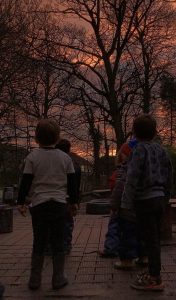
February
A new interest emerged in the Art Studio, the children's imaginations lead them down a path of story telling. Little did we know this was the start of a 6 month project. Watch the video below to see how it begun.
March
The first signs of spring emerged alongside World Book Day, an annual favourite at Inspirations. We celebrated Spring Equinox by Forest School and The Art Studio teaming up for a full day in the forest. We took our lunch with us and ate it beneath the trees, it was a wonderful opportunity for the children to have the freedom of time and space and to learn from our forest.
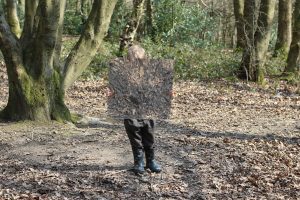
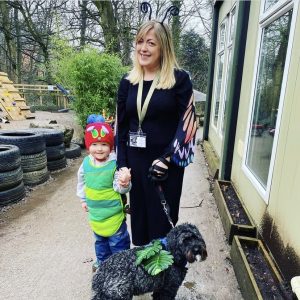
April
The babies took a trip to see the daffodils in the park, the toddlers were knees deep in soil as the garden was re-arranged to support their pouring, filling and digging interest. In the Art Studio in Pre-school we created a shadow puppet theatre so the children could use this as another platform of story telling. They created their own characters and turned them into paper puppets on sticks.
May
Our nursery therapy dog odin turned 5 years old!
June
Our whole nursery came together to have a tea party to celebrate the Queens Jubilee, with parents invited too. The Pre-schoolers performed a little ukulele song we made up together called 'You and Me at the Queen's Jubilee'; a song we still sing 6 months later. Have a listen below-
July
We had a heatwave for our Annual Summer Party, this year we did it a little differently and took over the school field with a carnival parade, steel drum band, BBQ and bouncy castle.
Our school Leavers had their graduation photoshoot.
August
Our many nursery apple tree's were producing plenty of apples, which inspired the children to open an 'Apple Shop'. A wonderful opportunity once again to learn from nature, whilst incorporating role play and maths with real coins.
August also saw the completion of our new staff room, which opened up the previous staff room as a dinning room for our pre-school children in the colder months. The New Staff room is much bigger to accomodate our growing number of staff and is tucked away next to the Art Studio.
September
Jackson Pollock inspired Art in the Art Studio, we splatted paint, experimented with pendulum painting. The results can now be seen in the main entrence of nursery. The September winds provided perfect conditions for some kite flying in Forest School. It was also recycling week in September so our children had a big woodland tidy up to nurture care and respect for our environment and wildlife.
October
Our annual pumpkin picking trip and the festival of lights. Following our pumpkin haul we melted crayons onto the pumpkin when the children expressed they wanted a 'rainbow pumpkin'.
November
We celebrated Nursery Rhyme Week across the rooms in November, the baby room had activities linked to their favourite nursery rhyme '5 little ducks' .
December
And here we are, December 2022, one of the coldest on record. We had a pre-school trip to see Stick Man at the Playhouse Theatre, and they have been combining festive ingredients and smells to make cranberry cordial.
We thank all of our children, parents and staff for another wonderful year. We will look forward to welcoming you all back from 7.30 am Tuesday 3rd of January, but in the mean time we wish you all a happy and healthy festive period.
'The best classroom and richest cupboards are roofed only by the sky'- Margaret Mcmillen
Nathalie
The Importance of Speech and Communication
The pre-school years are an important stage in a child’s language development. It ensures the foundations are in place for later learning, literacy and forming relationships. At Inspirations nurseries we provide a language rich environment incorporating the Reggio Emilia Approach into our pedagogy. The children’s voice is at the heart of our ethos and is encouraged at every opportunity. Group morning meetings enables children to express their thoughts, ideas and experiences, as well as listening to other’s and asking questions which has a positive impact on confidence and self-esteem.

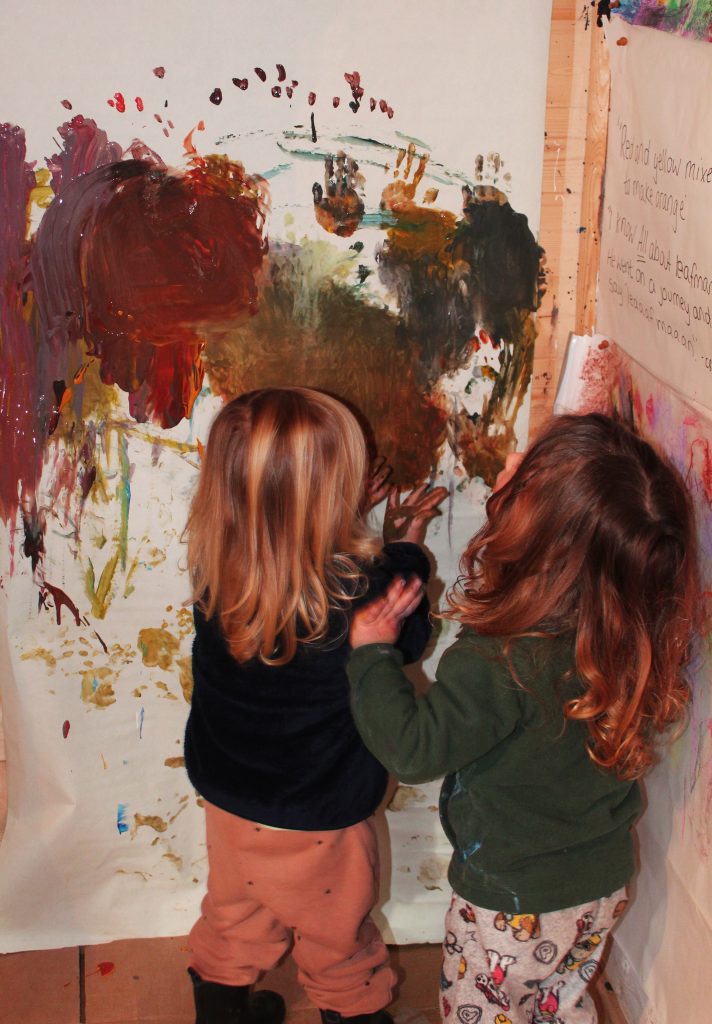
Communication enables children to build relationships. By interacting and playing
using speech and language, a child develops social skills and friendships that
support their well-being. Free choice play using loose parts, role play resources
and provocations allow children to use their own ideas and creativity whilst
encouraging interaction and communication. Children will play together in a mud
kitchen, using real size pans and bun trays chatting and problem solving to find
the perfect amount and size of stones to make cupcakes, or how much water to
add to the soil to make a delicious mud pie.
Children should be seen and heard
As children learn and use new vocabulary, they gain confidence in speech and
expression supporting development of reading and writing skills. We love books
at Inspirations and our practitioners read fiction and non-fiction books regularly
with children, expanding their vocabulary and knowledge as well as may other
skills. More exposure leads to better spelling, grammar, writing, and oral
communication.
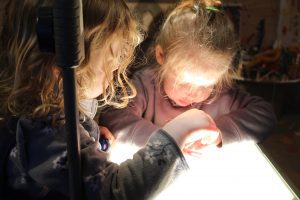
Singing Nursery rhymes with our young children daily helps them to develop an
ear for our language. Both rhyme and rhythm promote children to hear the
sounds and syllables in words, which helps children learn to read. The sooner a
child learns to read, the more opportunities they have to encounter the written
word. Teaching children phonetic sounds is also something we do to support
speech clarity and differentiation as well as reading and writing skills.
Ofsted have re-affirmed the evidence that children with delayed speech and
language are: '...less able to access the curriculum and to articulate their
thoughts and feelings. This can have a negative impact on their personal, social
and emotional development.' Therefore, good speech, language and
communication skills support educational and social achievement for the future of
our children which is why we have such an emphasis in our early years settings.
Children should be seen…and heard.
-Deborah
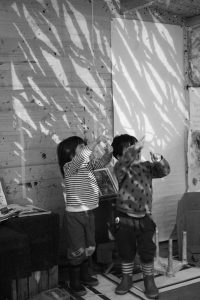
Looking Out For Forest Friends
Rounded body, short dark yellow-tipped spines and a short tail – is it a Gruffalo I hear you ask? No, it's the Hedgehog!
Hedgehogs are a picture of cuteness and are largely widespread throughout Britain. In the summer time they spend most of their days sheltering in moss, grass, leaves and hedges. In fact, the reason they are called 'Hedge' hogs is because of where they build and nestle in hedges, bushes and shrubs. The ‘hog’ part comes from the small snorting and grunting sounds they make, which is similar to a pig.
There are a few facts about Hedgehogs, for example;
- They are nocturnal
- They can hibernate
- There are 15 species of hedgehog
- They have 5000 spikes
- Their snout is long to help them forage for food, such as worms, insects and berries
- They are lactose intolerant
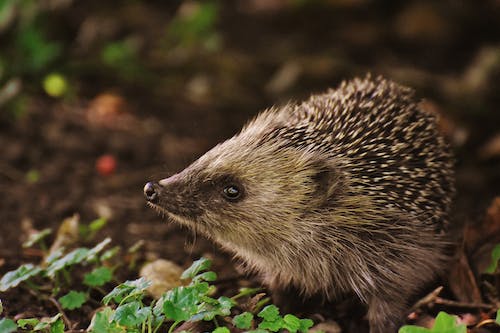 Hedgehogs tend to forage in the evening and can travel for up to 2 miles, that’s a long way for little legs! They are known for being a Gardeners’ Friend and have earned this reputation because of their eating habits. Not only do they enjoy berries and fruit but the staple of their diet is made up from pests that are common in our back gardens such as beetles and caterpillars. This helps preserve the
Hedgehogs tend to forage in the evening and can travel for up to 2 miles, that’s a long way for little legs! They are known for being a Gardeners’ Friend and have earned this reputation because of their eating habits. Not only do they enjoy berries and fruit but the staple of their diet is made up from pests that are common in our back gardens such as beetles and caterpillars. This helps preserve the
fruit and vegetables you may have growing in your gardens.
Vulnerable to Extinction
Sadly, Hedgehogs are at risk, so much so that they are classified as ‘vulnerable to extinction’ and are on Britain’s red list for mammals due to the sharp rate of it’s decline. Hedgehogs are one of the oldest mammals on the planet. They are Britain’s only spined mammal and a national favourite. But their numbers have fallen from over 30 million in the 1950s to less than one million today. More and more is being done to stop these spiky little creatures from becoming extinct. Recently The British Hedgehog Preservation Society ran a successful campaign to ensure that all new housing developments include hedgehog highways. This will help to give hogs the room they need to roam and find food and suitable mates. https://www.countryliving.com/uk/wildlife/countryside/a28604641/hedgehogs-building-rules
A garden can be a haven for Hedgehogs but decking, astroturf, gravel and paving, as well as neat cut back grass with no trees or bushes aren’t much use to our prickly friends. Such things as pesticides not only kill the bugs that they eat but also get into the Hedgehogs diet, causing them to become ill. Therefore, the introduction of Wildlife gardening is helping to maintain these habitable havens and is aimed at creating an environment that is attractive to various forms of wildlife such as Hedgehogs. The move towards this form of gardening and the great work done by the Hedgehog Street campaign has shown that even though there is still a decline in the countryside, in urban and suburban areas things are looking better. Thankfully this means that more and more gardens up and down the country are becoming hedgehog friendly. Is your garden Hedgehog friendly? There is one way you can help...
Get your own hedgehog highway!
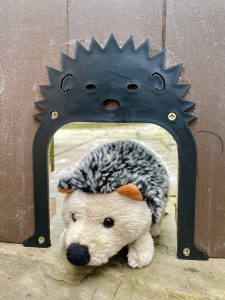
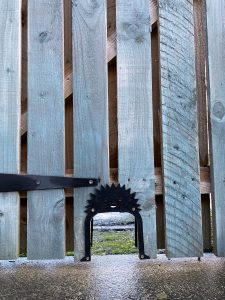
Let's open up our gardens again, to get your own Hedgehog Highway contact Handyman Ian local to the area. He will cut a hole in your fencing and attach a hedgehog frame just like this one for £12
Email: https://www.facebook.com/handyian84 Whatsapp:+44 7740 328619
Get involved in making your garden hedgehog friendly and perhaps we can work together to save this species from extinction.
- Ashleigh
Bad Weather is Good for You
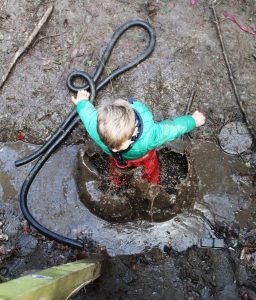
With this relentless rain of recent its easy to slip into the phrase 'bad weather', but there are in fact many benefits to being out in the colder, wetter, windier days. Our children at Inspirations are out in all weathers, embracing all that British weather has to offer, with the help of the right waterproof gear. But what if we told you being out in this weather is actually good for your health?...
The wind and rain can wash away pollution, germs and bacteria. If it’s a muddy forest, even better. Believe it or not, mud is a boon for your health. So rather than taking lengthy detours to avoid a stretch of quagmire, just walk right through it breathing deeply as you go. Mud – be it farmyard or forest floor – is rich in mood-enhancing microbes. Australian researchers found that mice exposed to soil had more diverse microbiomes, a finding mirrored by a Finnish study in which the gut and skin of children playing in plastic-and-concrete playgrounds were compared to those of children whose playground had been rebuilt using a tract of forest floor. In as little as four weeks, the children playing on forest floor had developed more diverse microbiomes. More importantly, the researchers found “parallel changes in the children’s immune systems”, with the muddy children showing greater immunity and fewer coughs and colds for months afterwards. Mud can be slippery, so use walking poles for stability. As you prod at the earth, you’ll also be releasing beneficial bacteria from the soil.
Read the full article here-



